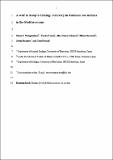Please use this identifier to cite or link to this item:
http://hdl.handle.net/10261/43596Share/Export:
 SHARE SHARE
 CORE
BASE CORE
BASE
|
|
| Visualizar otros formatos: MARC | Dublin Core | RDF | ORE | MODS | METS | DIDL | DATACITE | |

| Title: | A wolf in sheep’s clothing: carnivory in dominant sea urchins in the Mediterranean |
Authors: | Wangensteen, Owen S. CSIC ORCID; Turon, Xavier CSIC ORCID ; García-Cisneros, Álex CSIC ORCID; Recasens, Mireia; Romero, Javier CSIC; Palacín, Carlos CSIC ORCID | Keywords: | Trophic relationships Stable isotope analysis Benthic communities Arbacia lixula Paracentrotus lividus |
Issue Date: | 2011 | Publisher: | Inter Research | Citation: | Marine Ecology Progresss Series 441 : 117-128 (2011) | Abstract: | Arbacia lixula and Paracentrotus lividus are the dominant sea urchins in the Mediterranean sublittoral, where they are key structuring species due to their grazing activity. It has been commonly accepted that competition between both species is minimized by specializing in different algal foods: A. lixula is considered to feed mainly on encrusting coralline algae, while P. lividus prefers fleshy macroalgae. We used stable isotope analysis to test if these species occupy different trophic positions at three western Mediterranean and one Macaronesian locations. Our results unambiguously show that A. lixula always occupies a higher trophic level than P. lividus, with a δ15N comparable in some locations to strict carnivores such as Actinia schmidti or Marthasterias glacialis. A temporal monitoring at one locality showed that this signature of a higher trophic level is consistent throughout the year. These results are incompatible with the current belief of an herbivorous diet for A. lixula and suggest that it must be considered an omnivore tending to carnivory in Mediterranean ecosystems, feeding at least partially on sessile animals such as Cirripedia, Hydrozoa or Bryozoa. A parallel analysis of gut contents showed a predominance of vegetal items in both species, although A. lixula consistently had a higher abundance of animal components than P. lividus. Our results challenge the validity of using gut content observations alone for characterizing the trophic behaviour of omnivorous marine invertebrates that feed on a variety of food sources with different digestibility. | Description: | 12 páginas, 4 figuras, 6 tablas. | Publisher version (URL): | http://dx.doi.org/10.3354/meps09359 | URI: | http://hdl.handle.net/10261/43596 | DOI: | 10.3354/meps09359 | ISSN: | 0171-8630 |
| Appears in Collections: | (CEAB) Artículos |
Files in This Item:
| File | Description | Size | Format | |
|---|---|---|---|---|
| A wolf in sheep's clothing.pdf | 263,35 kB | Adobe PDF |  View/Open |
CORE Recommender
SCOPUSTM
Citations
68
checked on Apr 9, 2024
WEB OF SCIENCETM
Citations
66
checked on Feb 28, 2024
Page view(s)
456
checked on Apr 19, 2024
Download(s)
432
checked on Apr 19, 2024
Google ScholarTM
Check
Altmetric
Altmetric
WARNING: Items in Digital.CSIC are protected by copyright, with all rights reserved, unless otherwise indicated.
